The autonomous tractor market is estimated to be valued at US$ 2.70 billion in 2025 and is expected to reach US$ 12.45 billion by 2032, growing at a compound annual growth rate (CAGR) of 24.4% from 2025 to 2032.
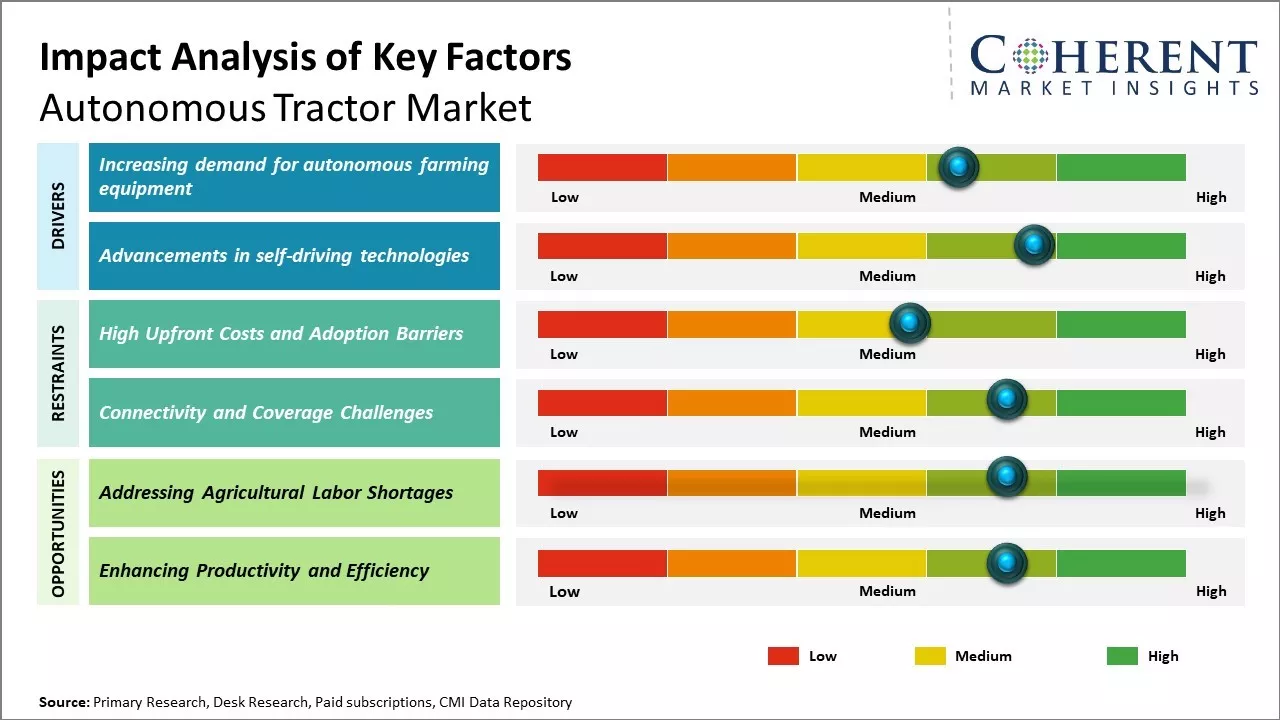
Discover market dynamics shaping the industry: Download Free Sample
The adoption of autonomous tractors is accelerating in order to reduce farming costs and improve crop yield. Various technology giants and automotive companies are investing heavily in the development of next-gen autonomous tractors integrated with advanced machine vision and navigation capabilities.
The market trend shows tremendous growth potential for autonomous tractors. Wide availability of GPS and guided steering systems are enabling higher degree of autonomy in tractors. Additionally, supportive government policies and subsidies for adoption of smart agriculture technologies are boosting demand. Low cost of ownership and increasing labor shortage on farms are major drivers for transition towards autonomous tractor-based smart farming globally.
Increasing demand for autonomous farming equipment
Traditional farming practices are increasingly becoming unsustainable due to lack of workforce. Farmers around the world are struggling to find reliable labor for performing various agriculture tasks such as tilling, seeding, spraying, and harvesting. This is causing delays in farm operations and negatively impacting crop yields. At the same time, the average age of farmers is rising steadily as newer generations are showing less interest in taking up agriculture as a career.
Autonomous tractors promise to alleviate the farm labor shortage issues by reducing dependency on human workers. These smart machines are capable of performing a variety of complex agriculture operations autonomously with minimal or no human intervention. Right from seeding to applying fertilizers and pesticides, and harvesting the ripe crops - autonomous tractors can complete all the work autonomously by following pre-programmed routines. The autonomous tractors are programmed to work for longer hours and can carry out operations even during night if required without compromising on productivity or quality of work.
For instance, December 2022 marked the debut of Monarch Tractor's autonomous electric tractors, developed in collaboration with Nvidia's artificial intelligence platform. Utilizing Nvidia's Jetson edge AI platform, Monarch's flagship product, MK-V smart tractor, promises autonomous farming operations, with initial deliveries slated for December 2022 in California.
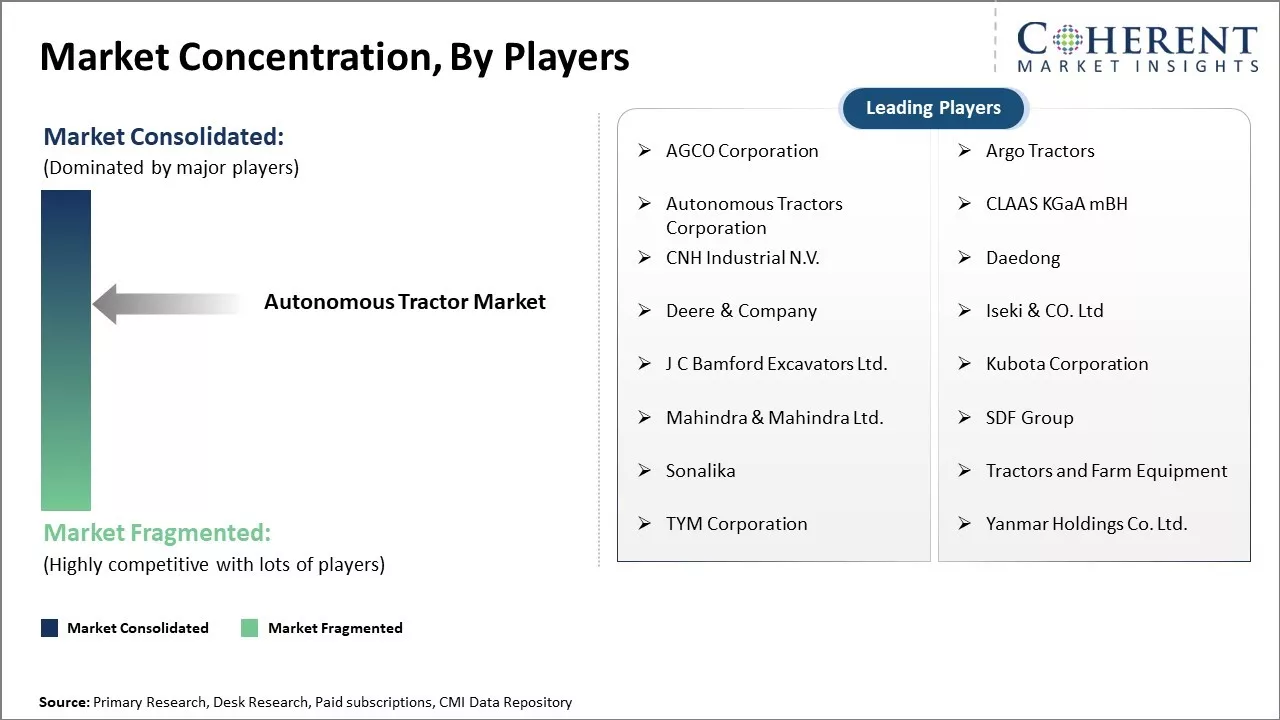
Get actionable strategies to beat competition: Download Free Sample
Advancements in self-driving technologiesOver the past decade, considerable research efforts as well as private investments from technology giants have fueled developments in fields such as computer vision, sensor fusion, navigation, and deep learning. Advanced algorithms are now enabling machines to efficiently process huge amounts of multivariate data from sensors in real-time and make independent decisions to navigate complex outdoor environments.
For instance, according to the Indian Council of Food and Agriculture (ICFA), India is projected to experience a 25.7% decline in agriculture workers by 2050, necessitating the adoption of technologies like autonomous tractors to address the acute shortage of skilled laborers and ensure productivity amidst evolving challenges. This trend serves as a significant driver propelling the autonomous tractor market forward.
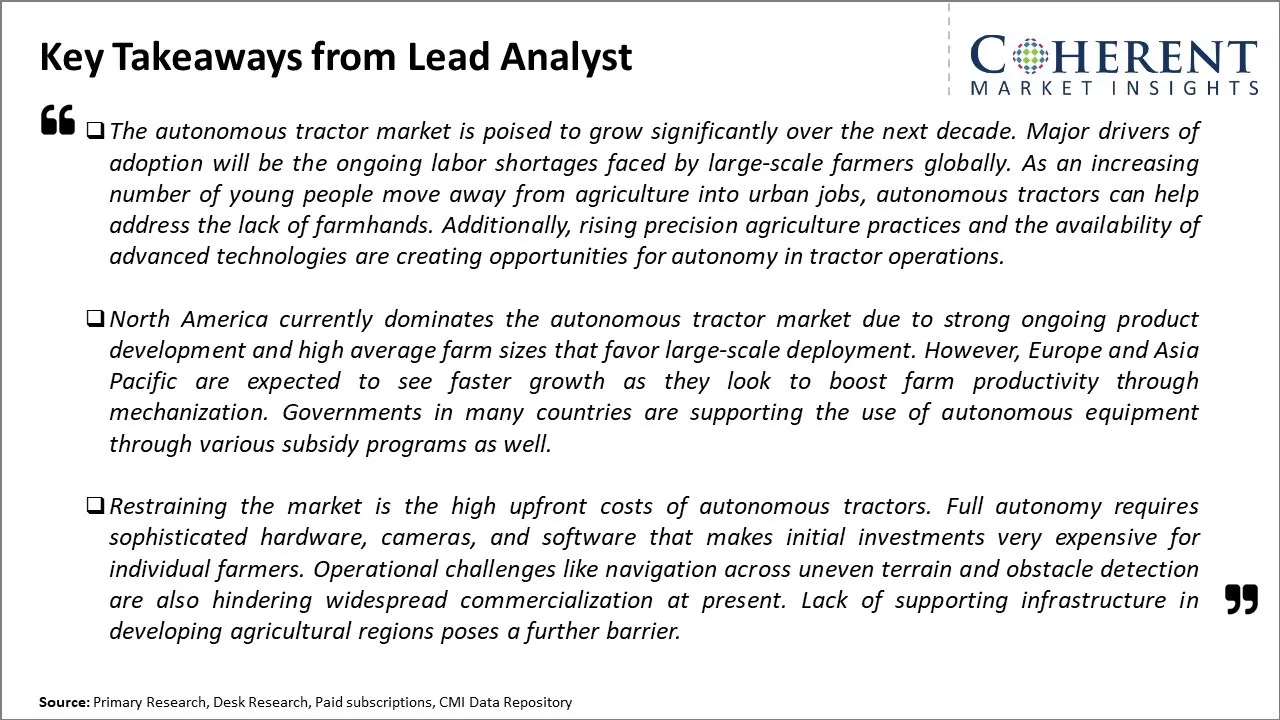
To learn more about this report, Download Free Sample
Market Challenges: High Upfront Costs and Adoption BarriersSome key challenges faced by the autonomous tractor market include high upfront costs for adopting newer technologies, maintaining connectivity across vast agricultural fields, and gaining farmer acceptance for new technologies replacing traditional farming practices. Additionally, unpredictable weather conditions and varying soil types present technical hurdles for autonomous system perception and decision making. Regulations also need to catch up with the evolving capabilities of self-driving farm equipment.
Market Opportunities: Addressing Agricultural Labor Shortages
The autonomous tractor market sees considerable opportunities in addressing the agricultural labor shortage, improving productivity and efficiency, reducing farmer costs over long term with driverless operations, and enabling dense precision farming and autonomous crop management. The growing consumer demand for food supplies push the need for large-scale commercial autonomous farms. Technology companies also seek to establish new revenue streams in agricultural automation and machinery control systems.
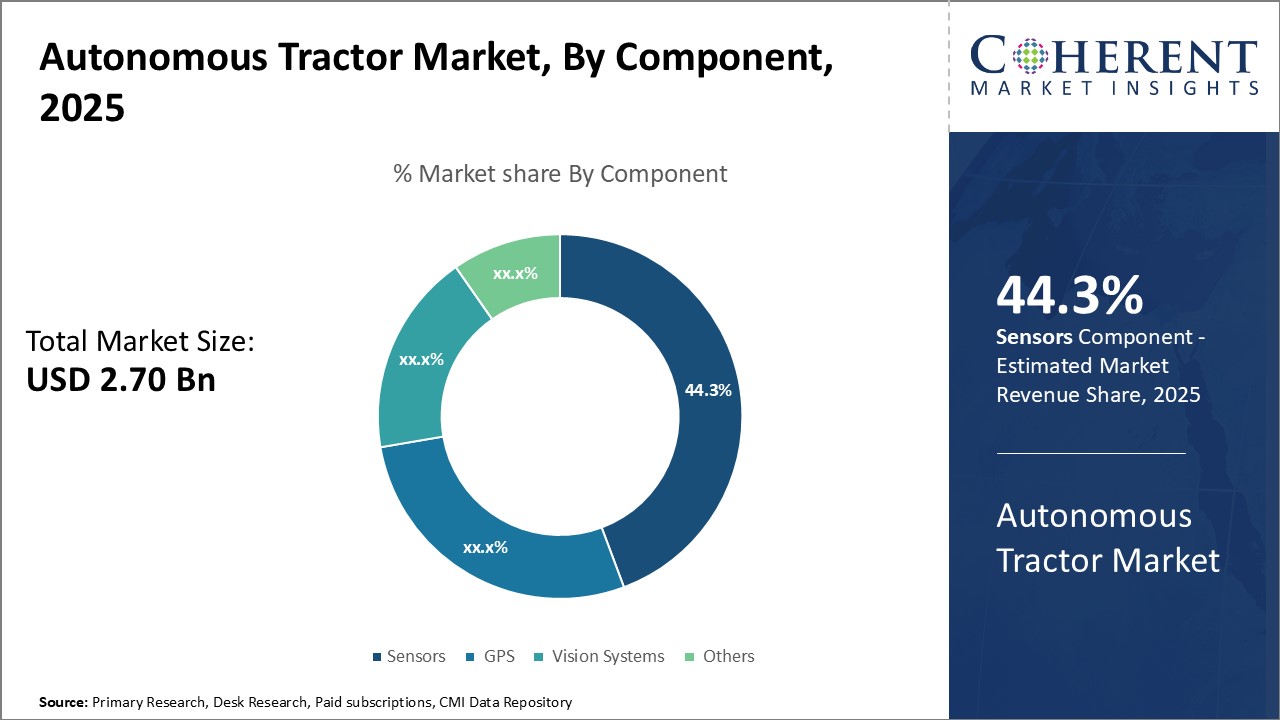
Discover high revenue pocket segments and roadmap to it: Download Free Sample
Insights, By Component- Driven by automation capabilities, sensors serve as the vital foundation for autonomous tractorsIn terms of component, sensors contributes the highest share of 44.3% in 2025, owing to their fundamental importance in enabling autonomous functionalities. Sensors allow tractors to perceive their surroundings by detecting things like obstacles, edges of fields, other vehicles, etc. Through continuous real-time environmental scanning via cameras, radar, and Lidar sensors, tractors gain a dynamic understanding of the operational landscape. This perception capability is integral for autonomous tractors to navigate, make decisions, and perform tasks without human assistance. Compared to other components like GPS and vision systems, sensors offer a more direct and comprehensive machine perception ability. Additionally, various types of sensors cater to different perception needs - for example, cameras capture images for object identification while radar detects distances to obstacles. The diverse application scope of sensors makes them applicable to a wide range of autonomous farm machinery. Their critical role in supporting core autonomous capabilities like guidance, mapping, and implements control has propelled the sensor segment to dominate the component landscape.
Insights, By Application- Precision automation drives the demand for autonomous tractors in tillage operations
In terms of application, tillage is expected to contribute the highest share of 36.89% in 2025, owing to its suitability for precision automation. As a primary field preparation process, tillage lays the groundwork for optimal soil health and crop yields. The repetitive nature and large acreage coverage needs of tillage make it well-aligned with automation. Autonomous tractors with advanced guidance systems can complete tillage with precise consistency, eliminating issues like skipped areas and overlapping passes. This enhances uniformity and resource optimization. Additionally, autonomous functionalities free up farmers and operators for other important tasks while the tillage is carried out autonomously round the clock. The scale and standardized nature of tillage operations thus drive significant demand for autonomous technologies to introduce an automated, precise and efficient approach.
Insights, By Power Output- Precise field coverage needs drive the adoption of mid-hp autonomous tractors
In terms of power output, the 51-100 HP segment is expected to contribute the highest share of 35.41% in 2022, owing to its ideal match with diverse autonomous application requirements. Tractors in the mid-hp range have sufficient power and versatility to handle a variety of tasks across different farm sizes through various implements and equipment. Their modular capacity also allows optimal deployment based on precise acreage and crop type. For example, a 75HP autonomous tractor can efficiently perform tillage, seeding, spraying and harvesting in a standardized manner across average sized plots. Additionally, mid-hp tractors offer lower operational costs compared to higher hp models. Affordability thus drives wider technology adoption amongst small and medium farmers. With tailored power matched to diverse precision field coverage needs, the 51-100 HP category is optimally positioned to lead autonomous tractor adoption.
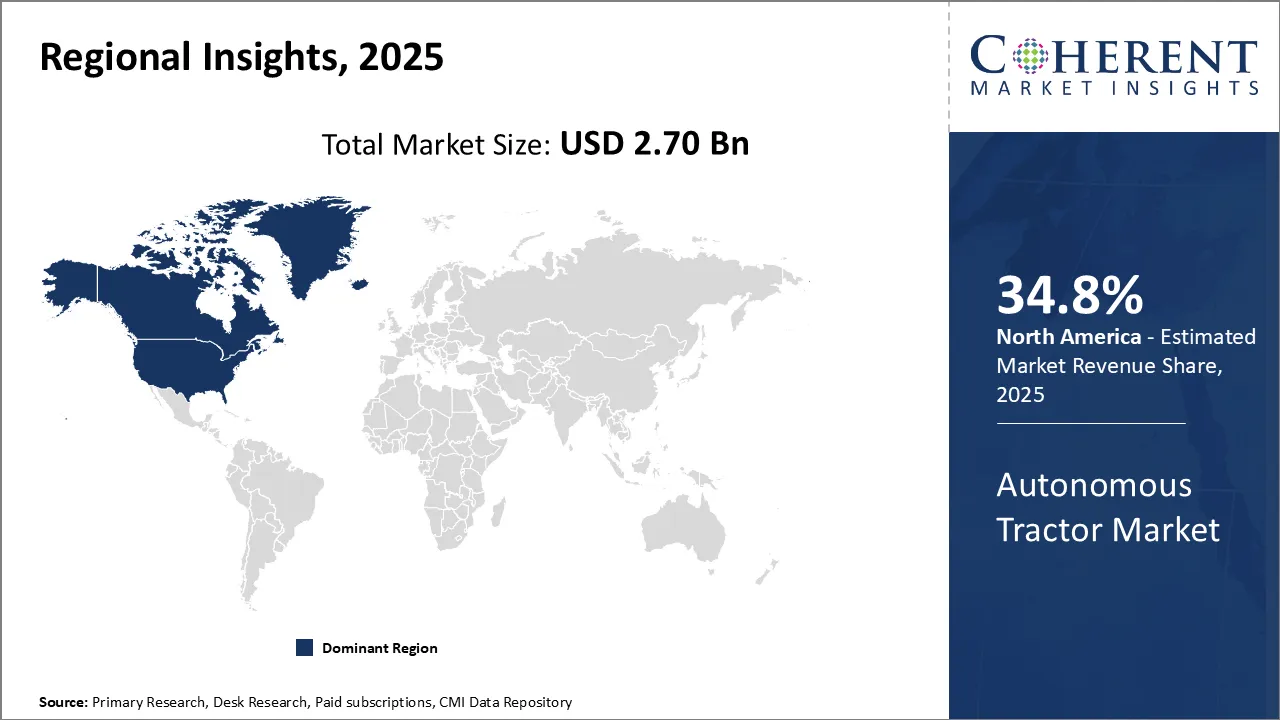
Need a Different Region or Segment? Download Free Sample
In 2025, the autonomous tractor market anticipates North America to dominate, holding the largest market share of 34.8% in 2025, as compared to other regions. This robust market position underscores North America's significant role in driving advancements and adoption of autonomous tractor technologies. Moreover, the region is poised to exhibit the highest market Compound Annual Growth Rate (CAGR) of 29.25% in the same year, surpassing growth rates in other regions.
Various technology giants and startups are developing innovative solutions focused around precision agriculture and autonomous farming equipment. This has resulted in the large scale commercial deployment of autonomous tractors on farms, especially in corn belt states like Iowa, Illinois, and Nebraska. Several tractor manufacturers already offer autonomy as an add-on feature or sell fully autonomous models. The widespread adoption is supported by the risk-taking attitude of local farmers and availability of large land holdings suitable for autonomous operations. Furthermore, agriculture is a major industry and political priority in the region which ensures strong government backing for new technologies.
Autonomous Tractor Market Report Coverage
| Report Coverage | Details | ||
|---|---|---|---|
| Base Year: | 2024 | Market Size in 2025: | USD 2.70 Bn |
| Historical Data for: | 2020 To 2024 | Forecast Period: | 2025 To 2032 |
| Forecast Period 2025 to 2032 CAGR: | 24.4% | 2032 Value Projection: | USD 12.45 Bn |
| Geographies covered: |
|
||
| Segments covered: |
|
||
| Companies covered: |
AGCO Corporation , Argo Tractors , Autonomous Tractors Corporation, CLAAS KGaA mBH, CNH Industrial N.V., Daedong, Deere & Company, Iseki & CO. Ltd, J C Bamford Excavators Ltd., Kubota Corporation, Mahindra & Mahindra Ltd., SDF Group, Sonalika, Tractors and Farm Equipment, TYM Corporation, and Yanmar Holdings Co. Ltd. |
||
| Growth Drivers: |
|
||
| Restraints & Challenges: |
|
||
Uncover macros and micros vetted on 75+ parameters: Get instant access to report
Share
Share
About Author
Gautam Mahajan is a Research Consultant with 5+ years of experience in market research and consulting. He excels in analyzing market engineering, market trends, competitive landscapes, and technological developments. He specializes in both primary and secondary research, as well as strategic consulting across diverse sectors.
Missing comfort of reading report in your local language? Find your preferred language :
Transform your Strategy with Exclusive Trending Reports :
Frequently Asked Questions
Joining thousands of companies around the world committed to making the Excellent Business Solutions.
View All Our Clients